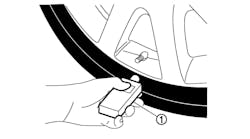Expert Advice: When Should a Vehicle’s Suspension Parts be Replaced?
When it comes to suspension performance, preventive maintenance can be a hard sell — even as the vehicle sinks closer to the road surface.
So we asked two former Modern Tire Dealer Tire Dealers of the Year, Alpio Barbara and Barry Steinberg, and a number of suspension parts companies one question: When should suspension parts be replaced?
“We often ask our clients if the car ever makes any unusual noises going over bumps or around turns just to get them talking about the ride aspects of their vehicle,” said Barbara, owner and president of Redwood General Tire Service Co. in Redwood City, Calif. “Suspension noises are often described with words such as tapping, rattle, or squeak over bumps, or just something that wasn’t there before.
“Luckily, a trained mechanic can identify the cause of most issues with some simple inspections. Different failures make different noises, so after road testing a vehicle and duplicating the noise the customer has described, a technician can begin to inspect the area the noise is coming from and begin to inspect those components for wear.”
Barbara said suspension component wear is usually diagnosed by testing for excessive movement or play.
“The fact of the matter is suspension parts all wear at different rates and in different ways depending on driving conditions, driving habits, as well as other factors. So rather than set a specific value for time and mileage for these parts to fail, it is our job in the automotive industry to help educate customers on what the suspension of their vehicle will do for their daily driving habits, as well as how wear and failure of these components can lead to serious safety concerns.”
Steinberg, owner of Direct Tire & Auto Service, a six-store chain based in Watertown, Mass., said if the part is showing enough wear or play that it will adversely affect alignment angles, he will recommend replacement.
“With the advancement of crash avoidance systems in the modern automobile, suspension systems must be evaluated and diagnosed by an informed and highly trained technician to understand the many dynamics of these systems. It is certainly not like the old days when we use to say 50,000 miles on shocks is the time to replace. Wear and tear is the focus, not mileage.”
Under both normal and adverse conditions, just about any suspension part can be damaged and wear out, but most should last 50,000 to 80,000 miles before repairs are required, says Doug Taylor, product marketing manager for Arnott Inc.“Air suspension, while offering load leveling and a more comfortable ride, also offers its own challenges,” he says. “While air suspension components can last eight to 10 years, like other rubber components such as hoses, wipers and tires, the rubber air bladder will begin to dry rot and develop tiny holes around the area where the rubber air spring folds upon itself.
“At first, the air suspension compressor will continue to pump up the springs, but in time the holes will become too numerous or too large, and the compressor will burn out and stop working from overuse.”
Air suspension components typically fail between 80,000 to 120,000 miles, said Aalok Joshi, director of product management for Cardone Industries. “This range can be greatly affected by the complexity and configurability of the system, aka driving modes, driver behavior and road conditions.”
Inspect wheel hub assemblies, U-joints and center support bearings on a regular basis, says an SKF USA Inc. spokesperson. Although these components do not have a specific replacement schedule, they can start to develop symptoms such as noise or vibration issues that may indicate it’s time to replace them.
It’s also important to ask customers if they are experiencing any issues.
A visual inspection of U-joints and center support bearings can determine if there is grease leakage or worn rubber supports. By grabbing the driveshaft and moving it, you can see if there is any excessive play. Wheel hubs also can be inspected for excessive movement.
“Typically, a hub will not have more than 5 thousandths end play,” he added.
In all cases, technicians should also refer to OEM specs for allowable limits. ■
5 signs an air suspension system needs repair
1. Customer complains that at least one corner of his vehicle is dropping over time.
2. The dashboard suspension warning light comes on.
3. The air suspension compressor stops working.
4. Upon a visual inspection, the technician sees leaking oil around the shock’s body or holes on the air spring.
5. Customer hears knocking noises when going over bumps.
Source: Doug Taylor, product marketing manager, Arnott Inc.





